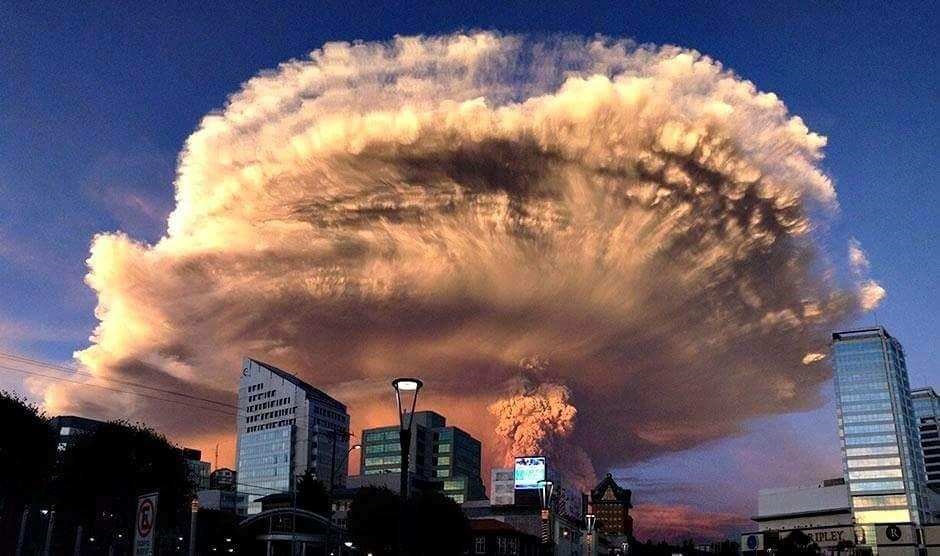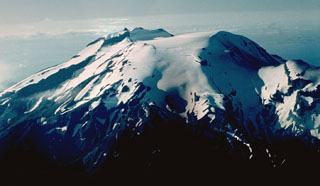Report on Calbuco (Chile) — June 2015
Bulletin of the Global Volcanism Network, vol. 40, no. 6 (June 2015)
Managing Editor: Edward Venzke.
Research and preparation by Paul Berger.
Calbuco (Chile) Eruption during 22-27 April 2015 with plumes above 15 km altitude; evacuations
Please cite this report as:
Global Volcanism Program, 2015. Report on Calbuco (Chile) (Venzke, E., ed.). Bulletin of the Global Volcanism Network, 40:6. Smithsonian Institution. https://doi.org/10.5479/si.GVP.BGVN201506-358020
Calbuco
Chile
41.33°S, 72.618°W; summit elev. 1974 m
All times are local (unless otherwise noted)
Since an eruption in 1972, Calbuco's activity had been limited to a weak fumarole emission in May 1995 and a strong fumarole emission in August 1996 (BGVN 21:09). No further activity was reported until increased seismic activity and an eruption in April 2015. The volcano is monitored by the Observatorio Volcanológico de los Andes del Sur - El Servicio Nacional de Geología y Minería (OVDAS-SERNAGEOMIN).
According to OVDAS-SERNAGEOMIN, Calbuco erupted explosively at 1804 on 22 April 2015, sending an ash plume to more than 15 km above the crater, where it drifted primarily ENE (figure 1). The eruption had been immediately preceded by only 2-3 hours of increased seismicity (one hour of volcano-tectonic events followed by long-period events). During the 90-minute eruption, column collapses occurred locally and radially, affecting the headwaters of major rivers.
 |
Figure 1. Photograph of the Calbuco explosion on 22 April 2015, taken from Puerto Montt, about 30 km SW of the volcano. Photo by Keraunos ob, posted on the Earth of Fire blog by Bernard Duyck. |
On 23 April at 0100 stronger activity began which lasted six hours and generated another ash plume that rose higher than 15 km and drifted NNE and E. Incandescent tephra was ejected as far as 5 km; deposits were concentrated to the N and NE, with thicknesses varying from tens of centimeters in the Región de Los Lagos to a few millimeters in the Los Ríos and La Araucanía regions. Pyroclastic flows traveled a maximum distance of 7 km and lahars traveled 15 km. Pumice fell in Región de Los Lagos, and ash fell in Los Ríos and La Araucanía. Tephra also fell in Argentine territory, NE of the volcano. Several roads and bridges were impassable due to ashfall. Scientists aboard an overflight observed ash emissions from at least six vents on the W, SW, and S sides of the old lava dome.
The eruption prompted OVDAS-SERNAGEOMIN to raise the Volcanic Alert Level from Green to Red (highest on a four-color scale). The Oficina Nacional de Emergencia del Ministerio del Interior (National Office of Emergency of the Interior Ministry, ONEMI) called for the evacuation of all people within 20 km of the volcano. About 5,000 residents were evacuated. ONEMI also warned people not to go within 200 m of drainages due to lahar hazards.
On 23 April at around 2330, a third period of activity resulted in ash plumes rising 2 km and drifting NE and E. On 24 April the ash plume continued to rise 2 km and explosions were detected. News articles noted that international travel was disrupted; flights in and out of several major cities were delayed or canceled. Thermal anomalies, based on MODIS satellite data, were also observed during 23-24 April.
According to one news report, ash from the eruption reached southern Brazil on 25 April, prompting some airlines to cancel flights in and out of Santiago, Buenos Aires, and Montevideo. Some houses in areas near the volcano had collapsed from the weight of the ash. Sporadic explosions caused continued ash plumes 25 April, but to a lower height of 400 m. Seismicity declined during 26-27 April; ash rose 1.5 km, and drifted NE and SE.
By 28 April, a satellite-based estimate of sulfur dioxide emissions was 0.3-0.4 Tg (Tg is one million metric tons), detected as high as 21 km altitude. Although most ash had fallen out of the plume over Chile and Argentina, some may have remained in the stratospheric plume drifting around the globe; the leading edge of the gas plume was detected over the Indian Ocean, S of Madagascar.
Seismic activity gradually declined, especially after 15 May 2015. OVDAS-SERNAGEOMIN reduced the Alert Level to Orange on 19 May and Yellow on 28 May. During the first part of August 2015, the Alert Level was decreased to Green, the lowest level. However, ONEMI maintained the Alert Level of Yellow for the province of Llanquihue and city of Puerto Octay (45 km NW of Calbuco), and an Alert Level Green for the cities of Puerto Montt (31 km SW of Calbuco) and Puerto Varas (31 km W of Calbuco).
According to ONEMI, on 18 August 2015 OVDAS-SERNAGEOMIN reported that seismicity fluctuated at low levels and continued to decline, with only water vapor rising from the vents. On 21 August the 10-km exclusion zone around the volcano was lifted, but SERNAGEOMIN warned that the 1.5 km exclusion zone around the craters remained in effect and the public should continue to stay away from drainages.
Geological Summary. Calbuco is one of the most active volcanoes of the southern Chilean Andes, along with its neighbor, Osorno. The late-Pleistocene to Holocene andesitic volcano is immediately SE of Lake Llanquihué in the Chilean lake district. Guanahuca, Guenauca, Huanauca, and Huanaque, all listed as synonyms of Calbuco (Catalog of Active Volcanoes of the World), are actually synonyms of nearby Osorno volcano (Moreno 1985, pers. comm.). The edifice is elongated in a SW-NE direction and is capped by a 400-500 m wide summit crater. The complex evolution included collapse of an intermediate edifice during the late Pleistocene that produced a 3-km3 debris avalanche that reached the lake. It has erupted frequently during the Holocene, and one of the largest historical eruptions in southern Chile took place from Calbuco in 1893-1894 that concluded with lava dome emplacement. Subsequent eruptions have enlarged the lava-dome complex in the summit crater.
Information Contacts: Oficina Nacional de Emergencia del Ministerio del Interior (National Office of Emergency of the Interior Ministry, ONEMI) (URL: http://www.onemi.cl/); Observatorio Volcanológico de Los Andes del Sur (OVDAS) del Servicio Nacional de Geología y Minería (SERNAGEOMIN) (URL: http://www.sernageomin.cl/); Hawai'i Institute of Geophysics and Planetology (HIGP) MODVOLC Thermal Alerts System, School of Ocean and Earth Science and Technology (SOEST), Univ. of Hawai'i, 2525 Correa Road, Honolulu, HI 96822, USA (URL: http://modis.higp.hawaii.edu/); Wall Street Journal (URL: http://www.wsj.com/); Reuters (URL: http://www.reuters.com/); Simon Carn, Geological and Mining Engineering and Sciences, Michigan Technological University, 630 Dow Environmental Sciences, 1400 Townsend Drive, Houghton, MI 49931 USA (URL: https://so2.gsfc.nasa.gov/); Earth of Fire Blog (Bernard Duyck), 23 April 2015 (URL: http://www.earth-of-fire.com/archive/2015-04/).

